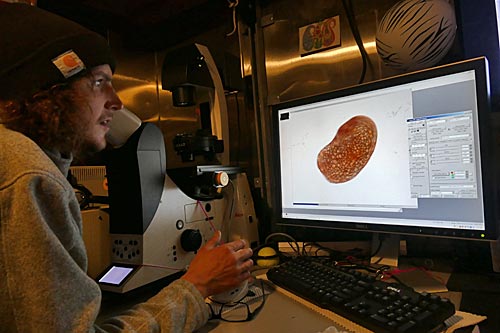Cruise Day 41
Speed 6 knots (kts)
Course 132° (SE)
Location Alpha Ridge, ~427 nautical miles south of N. Pole
Depth 2834 m
GO DEEPER DISCUSSION: (see previous journal for the questions.)
The wind chill temperature (sometimes called wind chill factor or just wind chill) is an index of how cold the air feels. As wind increases, the wind chill drops because moving air more effectively removes heat from a person than still air does. This is due to increased convection, a form of heat transfer caused by circulating liquids or gasses. The actual temperature isn’t affected by wind, though. So if the air temperature was 34° F and the wind chill temperature 24°, a cup of water wouldn’t freeze. But the water would cool down to 34° faster in windy conditions than in still conditions.
TODAY’S JOURNAL:
We continue south, with the water deepening as the southern portion of the Alpha Ridge transitions to the deep Canada Basin. Through much of the night and today, the navigators have been following long southerly-oriented leads that look like rivers running through the ice. The leads are only covered with thin new ice that the Healy effortlessly cruises through at 6 or 7 knots. Occasionally we lose a lead and break thicker ice again, accompanied by jolts, loud bangs, and scraping sounds. Occasionally a big hard piece of ice runs down the length of the hull making a sound like a giant’s fingernails running down a chalkboard. Our progress has been so swift that the next station’s estimated start time is now this evening instead of some time tomorrow morning or mid-day.
There’s plenty going on during transits, with folks analyzing samples, getting gear ready, or just resting up for another busy sampling station in our near future. Today I found Kyle Dilliplaine studying a very interesting class of organisms called sea ice meiofauna. As the name implies, these live within sea ice, but unlike the microscopic life I discussed earlier (Microscopic Life in the Ice, Sept. 14), meiofauna is just big enough to be visible to the bare eye. Meiofauna connotes very small but not microscopic life, and it is usually found living in tiny areas like the watery pore spaces between sand grains in marine sediment. Different biologists have different definitions for the size limits, but basically organisms from about 1/50 mm to 1 mm are in the ballpark. Up here in the Arctic, a whole community of tiny organisms live in the brine channels and pockets in sea ice, especially in the lower parts of the ice layer. These liquid spaces in the ice have high salinity due to the fact that salt gets excluded from the crystalline structure of ice as it forms, leaving behind ever saltier water known as brine. As water’s salinity increases, its freezing point decreases, so brine channels and pockets stay liquid within the solid ice pack, creating a wee thriving ecosystem.
As with most of Earth’s ecosystems, photosynthesizing organisms form the base of the food chain within sea ice brine. Lots of the producers Kyle finds in sea ice are diatoms, a type of algae that makes a silica cell wall. Non-diatom algae also grows in the protected sea ice brine habitat. These are eaten by small consumers from many phyla. Examples that Kyle has found in his sea ice studies include several types of worms (including flatworms, nematodes, and polychaete worms), ciliates, copepods, hydroids, and rotifers.

To search for meiofauna, Kyle first slowly melts ice core samples. The meltwater is then filtered through a 20 micron-mesh screen, catching any meiofauna from the melted ice. He rinses the screen into a tray with little curved wells, and searches these with a dissecting microscope for organisms. If any are found, Kyle catches them with a pipette and puts them onto a slide for more detailed study under a high-powered microscope.


I thought that one of the neatest things Kyle found today were tiny orange flatworms just under a millimeter long. They looked like little orange specks to the bare eye but like moving sphere-filled blobs under a microscope. They can swim around using cilia that line their bodies but also squirm around in wormy fashion. The worms have a special organ called a statocyst that helps them to feel which way is up and maintain their orientation. Most of the spheres in their bodies are lipids, which store energy (like body fat.)




GO DEEPER!
Many types of sea-ice meiofauna are from groups of organisms typically found in benthic (bottom) environments. How is sea ice similar to the benthic life zone? How is it different?
Aloft Con web cam updated every hour
Healy Track
That's all for now. Best- Bill


Comments